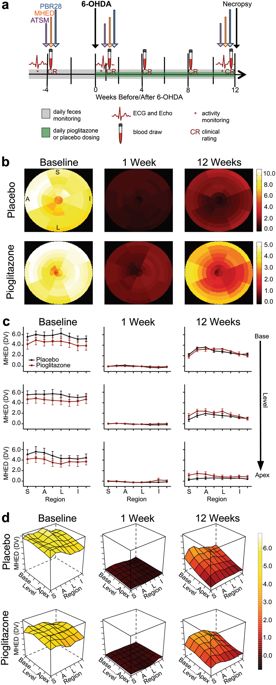npj Parkinson's Disease ( IF 6.7 ) Pub Date : 2018-07-13 , DOI: 10.1038/s41531-018-0057-1 Jeanette M Metzger 1, 2 , Colleen F Moore 3 , Carissa A Boettcher 1 , Kevin G Brunner 1 , Rachel A Fleddermann 1 , Helen N Matsoff 1 , Henry A Resnikoff 1 , Viktoriya Bondarenko 1 , Timothy J Kamp 4 , Timothy A Hacker 4 , Todd E Barnhart 5 , Patrick J Lao 5 , Bradley T Christian 5 , R Jerry Nickles 5 , Catherine L Gallagher 6 , James E Holden 5 , Marina E Emborg 1, 2, 5

|
Loss of cardiac postganglionic sympathetic innervation is a characteristic pathology of Parkinson’s disease (PD). It progresses over time independently of motor symptoms and is not responsive to typical anti-parkinsonian therapies. Cardiac sympathetic neurodegeneration can be mimicked in animals using systemic dosing of the neurotoxin 6-hydroxydopamine (6-OHDA). As in PD, 6-OHDA-induced neuronal loss is associated with increased inflammation and oxidative stress. To assess the feasibility of detecting changes over time in cardiac catecholaminergic innervation, inflammation, and oxidative stress, myocardial positron emission tomography with the radioligands [11C]meta-hydroxyephedrine (MHED), [11C]PBR28 (PBR28), and [61Cu]diacetyl-bis(N(4))-methylthiosemicarbazone (ATSM) was performed in 6-OHDA-intoxicated adult, male rhesus macaques (n = 10; 50 mg/kg i.v.). The peroxisome proliferator-activated receptor gamma (PPARγ) agonist pioglitazone, which is known to have anti-inflammatory and anti-oxidative stress properties, was administered to five animals (5 mg/kg, PO); the other five were placebo-treated. One week after 6-OHDA, cardiac MHED uptake was significantly reduced in both groups (placebo, 86% decrease; pioglitazone, 82%); PBR28 and ATSM uptake increased in both groups but were attenuated in pioglitazone-treated animals (PBR28 Treatment × Level ANOVA p < 0.002; ATSM Mann–Whitney p = 0.032). At 12 weeks, partial recovery of MHED uptake was significantly greater in the pioglitazone-treated group, dependent on left ventricle circumferential region and axial level (Treatment × Region × Level ANOVA p = 0.034); 12-week MHED uptake significantly correlated with tyrosine hydroxylase immunoreactivity across cardiac anatomy (p < 0.000002). PBR28 and ATSM uptake returned to baseline levels by 12 weeks. These radioligands thus hold potential as in vivo biomarkers of mechanisms of cardiac neurodegeneration and neuroprotection.
中文翻译:

心脏交感神经变性的非人类灵长类动物模型中炎症和氧化应激的体内成像。
心脏神经节后交感神经的丢失是帕金森氏病(PD)的典型病理。它随时间发展,与运动症状无关,并且对典型的抗帕金森氏疗法无反应。可以使用神经毒素6-羟基多巴胺(6-OHDA)的全身剂量在动物中模仿心脏交感神经变性。如在PD中一样,6-OHDA诱导的神经元丢失与炎症和氧化应激增加有关。为了评估检测心脏儿茶酚胺能神经支配,炎症和氧化应激随时间变化的可行性,使用放射性配体[ 11 C]偏羟麻黄碱(MHED),[ 11 C] PBR28(PBR28)和[ 61 ]进行心肌正电子发射断层扫描铜]二乙酰-双(N(4))-甲基硫代半碳胺酮(ATSM)在6-OHDA中毒的成年雄性恒河猴(n = 10; 50 mg / kg iv)中进行。将过氧化物酶体增殖物激活受体γ(PPARγ)激动剂吡格列酮对五只动物(5 mg / kg,PO)给药,已知具有抗炎和抗氧化的特性。其他五位患者接受安慰剂治疗。接受6-OHDA治疗一周后,两组的心脏MHED摄入量均显着降低(安慰剂,降低86%;吡格列酮,82%);两组均降低。两组中PBR28和ATSM的摄取均增加,但吡格列酮治疗的动物中PBR28和ATSM的摄取有所降低(PBR28处理×ANOVA水平p <0.002; ATSM曼惠特尼p = 0.032)。在第12周时,吡格列酮治疗组的MHED摄取部分恢复显着更高,这取决于左心室的圆周区域和轴向水平(治疗×区域×ANOVA水平p = 0.034)。在整个心脏解剖结构中,12周MHED摄取与酪氨酸羟化酶免疫反应性显着相关(p <0.000002)。到12周时,PBR28和ATSM的摄入量恢复到基线水平。因此,这些放射性配体具有作为心脏神经变性和神经保护机制的体内生物标记物的潜力。











































 京公网安备 11010802027423号
京公网安备 11010802027423号